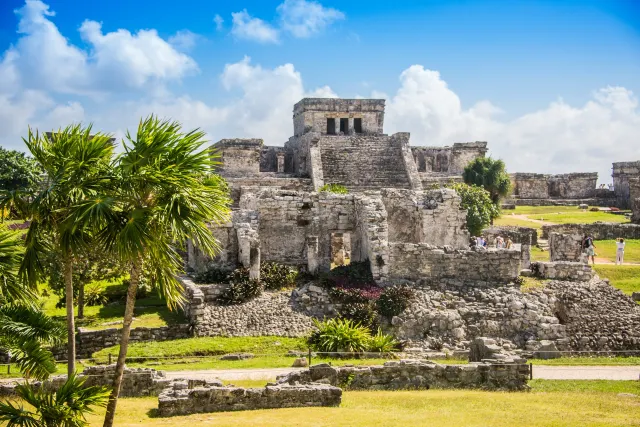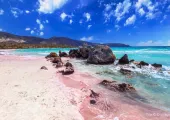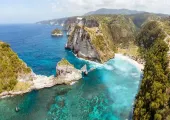Tulum Ruins: World Heritage Site You Cannot Miss in Cancun Mexico
Catalogue
- Entering The Ruins
- Tulum Walls
- Temple of The Wind
- El Castillo
- Temple of The Frescoes
- House of The Columns
- Temple of The Descending Gods
- House of The Halach Uinic
- The Port and The Teach
- Tips for Visiting Tulum Ruins
Show More
Tulum Ruins is an awe-inspiring Mayan site which is different from other Mayan sites as the ruins are perched upon 39 feet cliffs, facing the Caribbean ocean. This picturesque place is not something you can miss while you are visiting Mexico’s Yucatan Peninsula. Tulum is also known as the “place of dawning Sun” as it faces the east and has a perfect view of the rising Sun. In Mayan, Tulum also means “fence” and rightly so as it was built to be a seaport fortress surrounded by cliffs and walls, which provided protection from all sides from invasions. Since Tulum had access to both land and sea, it was a major trading center and a religious hub during the 11th and 16th centuries. Goods like honey, jade, cotton, turquoise, cacao beans, and copper bells were some of the stuff which was being traded in this old Mayan city. Tulum Ruins are most certainly a delight to the archaeological wanderers as it is bound to take you back in time and reveal the charming histories of Mexico, hidden in its architectural ruins.
As you enter the fort through any of the five doorways in the wall, you could see the old stone structures surrounded by leaning palm trees, pretty cactus flowers and of course the steep rock cliffs. Welcoming you there will be quite a bunch of sun-baked large iguanas too. The maze of gently rolling hills will catch your eyes when you first step your foot in. Peeking from the sides would be black and grey outcroppings, remnants of what once used to be a building. You would come across two low corbel arch entryways, once you walk along the walls of Tulum and if you use the second entrance which is closer to the ocean, you would come across Casa Del Cenote or the house of Cenotes. These Cenotes were considered as the openings to Xibalba or the underworld and the discovery of an elaborate tomb at the floor of the House of Cenotes points towards it being a place for ceremonial functions as well.
You could also go through and gain information from the wonderful introduction to the history of Maya which you would find as you enter and move around the ruins.
The whole paraphernalia of cliffs, rocks, iguanas, cactus flowers would ignite anyone’s imagination and enter the ruins with wonder-filled eyes and heart, desirous to know what comes next and what happened to the civilization which lived here eons ago. What you see upon entering is something which will live up to your imagination. To your surprise, in spite of being a place always full of tourists, you would always find a serene and quiet place which would let you rejuvenate and bask in the natural beauty of this place and ruminate over the fascinating history behind these ruins.
As per the archaeological finding at Tulum Ruins, this place was inhabited as further back in history as 564 AD. Over time, many rulers came and went, and the city kept transforming itself generation after generation based on the lifestyle and habits of its inhabitants. That explains why many of the buildings here depict different architectural styles based on the year in which they were built or expanded. One interesting fact about Tulum Ruins is that at any given point, it did not have more than 1600 inhabitants, which shows that Tulum was not a population center but more of a religious or ceremonial center. Tulum was one of the last cities built by Maya.

Tulum was a well-fortified place and security was of utmost importance to its people. This is signified by the impressive Tulum walls which protect one side of the city while the other was protected by steep sea cliffs from invaders. These walls were 3-5 meters in height, 8 meter thick and 400 meter long running along the parallel side of the sea cliffs. This humungous and sturdy wall must have taken a lot of time, energy to be built so it is clear that defense was a very big thing for Tulum people. At other corners of the city are watch towers which further strengthened the safety of its people. The wall has 5 narrow gateways and a small Cenote on the side, which must have been used to provide fresh water to the city. This magnificent wall truly made Tulum as the best fortified city of Maya.
As you enter, you would find the Kukulcan group which is identified by a group of minor structures. Among these, the first structure which would catch your eye is the outstanding Templo del Dios del Viento or the Temple of the god of the wind. Its name comes from its unique round base upon which the temple is built. The circle represents the god of the wind in central Mexican cosmology, so this structure being here and other parts of Maya ruins goes to show the strong effect of central Mexican invasion on Maya societies.
This temple might look familiar to you as this is what you might find on many postcards, magazines, and tourist brochures. It is a great sight to behold as the structure stands royally on top of a rocky outcrop and one can see the breathtaking sandy cove from there.
It is indeed the most prominent and imposing structure among the Tulum Ruins, standing on a 12-meter limestone cliff. It is the tallest and the most famous building within Tulum settlement. It was used as an ancient lighthouse which sailors used to navigate the bay in the dark. Its two small windows at the top were useful for saving merchant boats from crashing into the reefs under water, as the captain could see light coming through both the windows. Like many Mayan structures, this castle was also built in phases with the first phase iteration spent on getting the low broad platform with the palace on the top having a brigade of stout columns. The second iteration consisted of filling the center portion to give a sturdy base for building a loftier temple at the top. It has an inner chamber where one can find a multitude of intriguing frescos and the lintels in the upper rooms have serpent motifs engraved into them.
There is a small cove at the base of the castle which seems to have been used as a perfect landing for trading canoes in the ancient times. It also explains why the city of Tulum was founded in this region since Tulum was later known as a major trading port between the 13th and 15th century. There is a stone block at the top of the stairs which the archaeologists believe might have been used as a place for offering sacrifices. This castle overlooks the Caribbean waters, and you cannot miss catching a glimpse of the sea, like a breath of fresh air, while coming down.

This is the best-preserved part of the Tulum Ruins which carries a lot of ancient mysteries within it. It can be deemed as the most spectacular buildings since one can see a mural with colored paints, still in its glory. The mural depicts all the worlds surrounding us, the dead, the living, the creator and the rain gods. It is located right in front of the El Castillo and is a small two-story building, with the first floor as larger of the two having two rooms and 4 monolithic structures and niches which have the figure of descending Gods carved in them. You can find large masks along a band of sculptures which is assumed to represent God Itzamna who was believed by Mayans to be the God of creator and resided in the sky.
The second floor is smaller with decorative red-colored handprints. Apart from being a decorative structure, the Temple of the Frescoes also had high social and religious importance. Going by its detailed decorations, magnificent murals, and sculptures one can understand that this was a place of deep veneration. The name of this structure comes from the existence of a mural in the backroom of its first floor which has mainly red, along with green, black and yellow male and female deities and snakes which are interlaced. It also has flowers, fruits, and ears of corns that were offerings to the God. This temple was initially used as an observatory for tracking movement of the Sun.
As the name suggests, this is a big complex building with four rooms, supported by a series of large columns. It is also called the Palace or El Palacio since this impressive place was once a residence for Mayan leaders and most important inhabitants of Tulum. It has numerous large rooms which were covered with roofs and supported by pillars and beams. The house is surrounded all over by benches made of stone which were used as a place to sit or possibly as bed too. There was a provision for the families to hold their religious ceremonies in the form of a sanctuary at the side of the building. This is one of the most complex structures in Tulum with six columns holding up the roof. The whole place is shaped like the letter L, making it difficult to build than other Mayan buildings. This building has 3 stories build on 279 by 115 foot foundation and it took several stages to get the whole building erected. Though much of the roof has collapsed one can still get a good feel of what this building would have looked like in its glory, an impressive and imposing structure indeed!
This is a temple which was built with another temple at the base with a single room and narrow staircase. At the temple’s façade is the carving of “diving God” sculpted with its head facing down which appears as a bird with wings. It is believed to be the protector of people in ancient Mayan times. This “diving god” sculpture appears to be the center of Tulum’s God-cult as this structure can be found throughout the Tulum at various sites. While its importance is still not totally comprehensible, it supposedly signifies bees (as Tulum majorly traded in honey) and war. These two aspects are intertwined as bees were crucial to the economy and religion and war was the primary means of gaining power and authority. Though there are various other theories disputing each other, some of those being Venus (a planet which Maya associated with birth and renewal), God of rains or the setting sun (as Sun and its movements were of very high significance for the Mayan people). You can still see traces of the original paints or sprays which were used in its interior walls by Maya. This temple is towards the left of El Castillo as you face the sea and this intricately designed building faces the Sun and gets illuminated brightly by the setting sun on April 6th which is believed to be the birthday of the descending God. The figure of descending God, though still a debatable subject among archaeologists, gives a significant glimpse of Maya culture and interesting insight into their political, economic and religious culture.
Each Mayan city was presided over by a high-priest also known as “Halach Uinic” who was the supreme leader of a Mayan Kuchkabal (form of government in pre-Columbian times). He was the one who controlled all power in the city and appointed all administrative officers in Maya times. This position was then passed on to the eldest son of the house. Many theories are revolving around as to why the city was walled or why the Mayan world declined. One theory for it being walled also says that priests and the nobilities were protected inside the walls and this building used to be their house. This house is one of the most well preserved buildings among Tulum ruins. Above the entrance of the house is an elaborate painting of the diving God which is protected by a thatched roof in modern times. One can infer that this house was not only the residence of the high priest but the figure of diving God underneath its red thatched roof depicts it was also used for religious and burial ceremonies.
As you descend from El Castillo, you enter the terrific Caribbean waters. This was an important part of Tulum settlement, with the port being used for trading and the beach was where the Mayan ships, which were dedicated to trading, docked. Now, this beach is a place to rest, swim and snorkel. One can definitely say that the beach is quite a big part of why Tulum ruins attract such a huge number of tourists. The young and the old, the kids and the couples, everyone can have a gala time in the waters after spending a full day at the ruins. You would also find many eateries, bookshops, a small museum around the place to keep you occupied and make your trip interesting.
It would take you a couple of hours to see the ruins, so it is better to tour it unguided since that will give you the freedom to choose where you wish to spend more time. But you could also spend a full day given that the Tulum Ruins blends into the Caribbean beach.
Mexico Sun is famous for its heat and humidity, so get lots of water and cold drinks to soothe you during your entire visit. Carry hats and glasses and wear comfortable clothes to combat the sun.
The place opens at 8 and closes by 5, and one must try to reach there in early hours so as to get the most of the place while it is still pleasantly warm as well as have a serene time before the tourists start thronging the place. Yes, Tulum Ruins is very high on the list of places to visit, which can be understood by Tulum’s massive parking lot. On an average 3287 people visit the ruins daily.
Be sure to get a sunscreen with you, to protect your skin and a bathing suit for an eventful beach time. You could wear your bathing suit inside your clothes as there are no changing rooms at the beach (changing rooms are only at the ticket counter), so it would be easy for you to jump into the sea. A towel would come handy if you do wish to swim or snorkel. The beach opens at 10 AM and while you walk down the wooden staircase towards the beach, look out for the iguanas as they are always around and might come in your way.
Tulum Ruins set with the backdrop of the Caribbean Sea is exquisite and pristine in its setting, the only Mayan city on the coast. When you visit this place, it is bound to invoke thoughts and imaginations about what kind of civilization lived here and what happened to them, so enjoy that mystery while you stroll around the ruins and walk along the beach for a visual drama.
Upcoming: Traveling to Cancun
Things to do in Cancun: 7 Reasons to Put Cancun Mexico Into Your Vacation Bucket List.
Things to do in Cancun: Top 15 Cancun All-Inclusive Resorts, Mexico Vacation 2019
Things to do in Cancun: Top 12 Things to Do in Cancun Mexico
Things to do in Cancun: Top Things to Do in Xplor Cancun Mexico
Things to do near Cancun: Why You Should Visit Mayan City of Tulum Once in Your Life Time
Things to do in Cancun: The Ultimate Guide for Xel-ha Park, Cancun Mexico
Things to do in Cancun: Free and add-on activities in Xel-Ha Park Cancun Mexico
Things to do near Cancun: Mexican Vacation: Things to Do in Playa del Carmen?
Things to do near Cancun: Top 10 Things to Do in Playa del Carmen Mexico
Things to do in Cancun: 5 Things to Know About Cancun Underwater Museum Mexico
Trending Travelogues
Popular Trip Moments
Popular Travel Types
Popular Attractions
Popular Ranked Lists
Popular Destinations
Recommended Attractions at Popular Destinations







Site Operator: Trip.com Travel Singapore Pte. Ltd.






